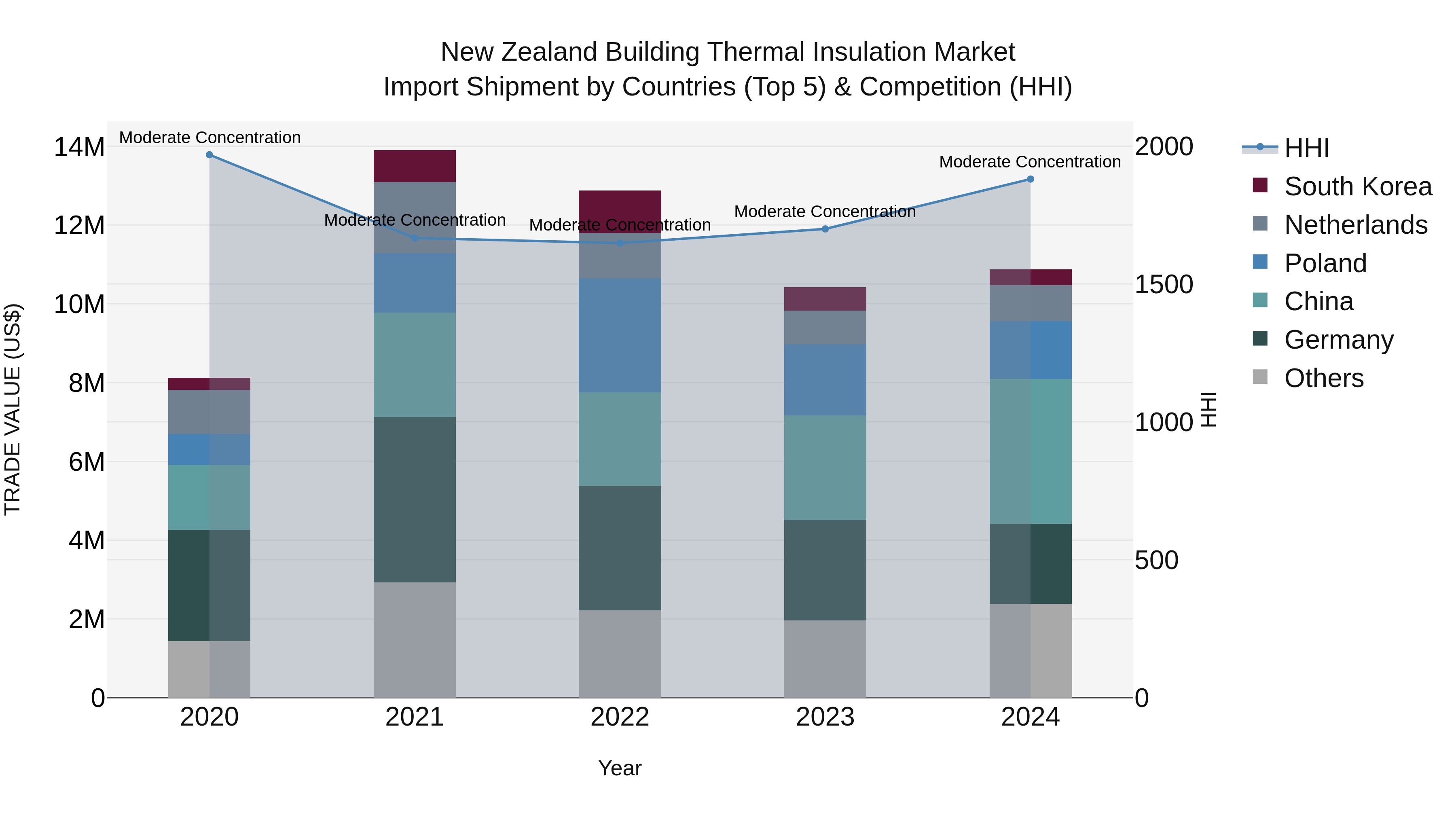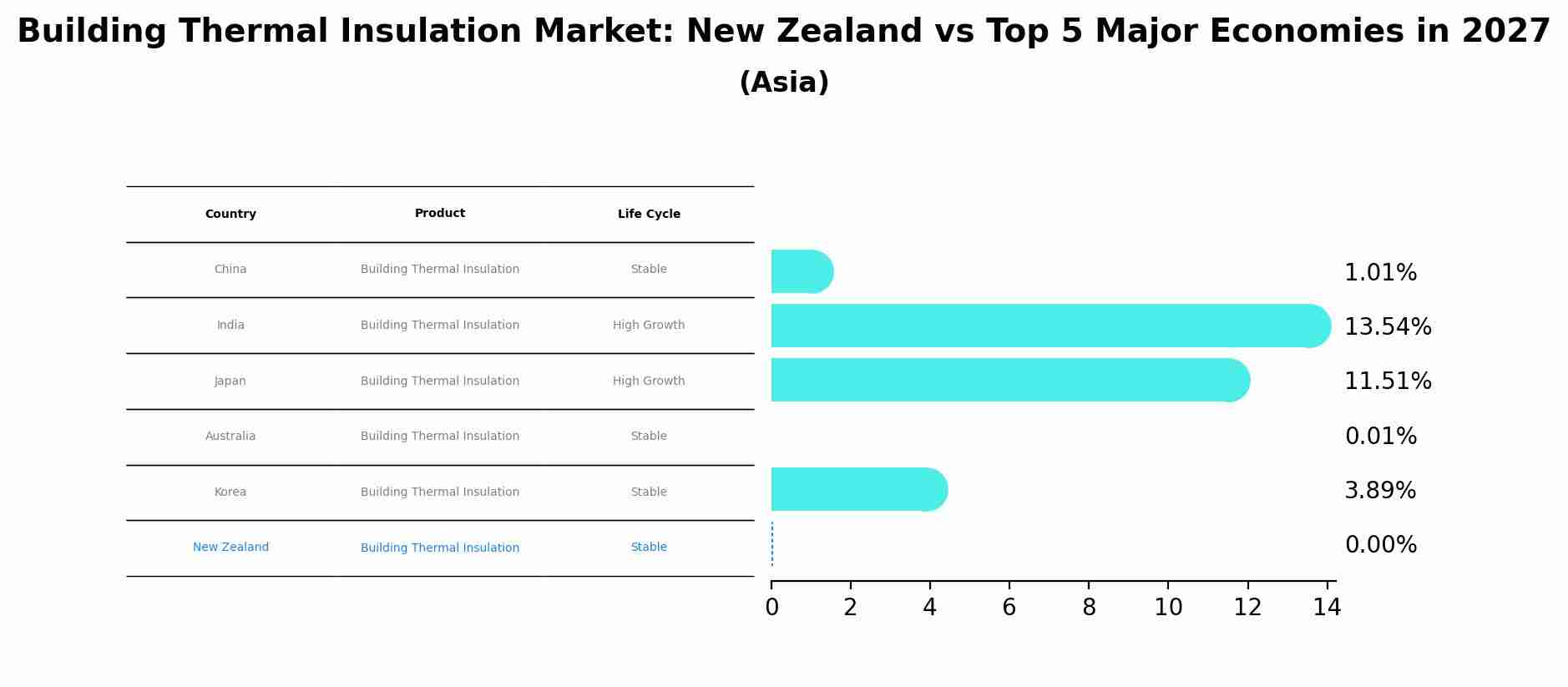New Zealand Building Thermal Insulation Market (2025-2031) | Revenue, Companies, Industry, Value, Analysis, Outlook, Size, Share, Segmentation, Trends, Growth & Forecast
| Product Code: ETC5742201 | Publication Date: Nov 2023 | Updated Date: Nov 2025 | Product Type: Market Research Report | |
| Publisher: 6Wresearch | Author: Sumit Sagar | No. of Pages: 60 | No. of Figures: 30 | No. of Tables: 5 |
New Zealand Building Thermal Insulation Market Top 5 Importing Countries and Market Competition (HHI) Analysis
New Zealand`s building thermal insulation import shipments in 2024 continue to be dominated by key exporters such as China, Germany, Poland, Netherlands, and Malaysia. The market shows moderate concentration with a steady Compound Annual Growth Rate (CAGR) of 7.57% from 2020 to 2024. The growth rate for the year 2024 is recorded at 4.37%, indicating a positive trend in the import market. These figures suggest a stable and growing demand for thermal insulation products in the New Zealand construction sector.

Building Thermal Insulation Market: New Zealand vs Top 5 Major Economies in 2027 (Asia)
The Building Thermal Insulation market in New Zealand is projected to grow at a stable growth rate of 0.00% by 2027, within the Asia region led by China, along with other countries like India, Japan, Australia and South Korea, collectively shaping a dynamic and evolving market environment driven by innovation and increasing adoption of emerging technologies.

New Zealand Building Thermal Insulation Market Overview
In the New Zealand building thermal insulation market, there`s a heightened focus on enhancing the energy efficiency and comfort of buildings, driven by stringent building codes and sustainability goals. Thermal insulation materials such as fiberglass, mineral wool, polystyrene, and polyurethane foam are widely used to reduce heat transfer through building envelopes, thereby lowering heating and cooling energy consumption. The market is witnessing a shift towards eco-friendly insulation materials with high thermal performance and minimal environmental impact. Moreover, rising awareness about the benefits of proper insulation in reducing carbon emissions and mitigating climate change impacts further propels market growth.
Drivers of the market
The New Zealand building thermal insulation market is witnessing significant growth driven by increasing awareness about energy efficiency and sustainability in construction practices. With a focus on reducing energy consumption and greenhouse gas emissions, there`s a rising demand for effective thermal insulation solutions in residential, commercial, and industrial buildings across the country.
Challenges of the market
The New Zealand Building Thermal Insulation Market struggles with the high cost of insulation materials and installation. There is a need to balance thermal performance with cost to make insulation solutions accessible to a wider market. Additionally, environmental regulations require the use of eco-friendly materials, which can be more expensive.
Government Policy of the market
The New Zealand government has implemented stringent building codes to improve energy efficiency in residential and commercial buildings. These codes mandate higher standards for thermal insulation, driving demand in the market. The Building Code Clause H1, which deals with energy efficiency, requires increased insulation in new constructions and significant renovations to reduce energy consumption for heating and cooling.
Key Highlights of the Report:
- New Zealand Building Thermal Insulation Market Outlook
- Market Size of New Zealand Building Thermal Insulation Market, 2024
- Forecast of New Zealand Building Thermal Insulation Market, 2031
- Historical Data and Forecast of New Zealand Building Thermal Insulation Revenues & Volume for the Period 2021-2031
- New Zealand Building Thermal Insulation Market Trend Evolution
- New Zealand Building Thermal Insulation Market Drivers and Challenges
- New Zealand Building Thermal Insulation Price Trends
- New Zealand Building Thermal Insulation Porter`s Five Forces
- New Zealand Building Thermal Insulation Industry Life Cycle
- Historical Data and Forecast of New Zealand Building Thermal Insulation Market Revenues & Volume By Material for the Period 2021-2031
- Historical Data and Forecast of New Zealand Building Thermal Insulation Market Revenues & Volume By Glasswool for the Period 2021-2031
- Historical Data and Forecast of New Zealand Building Thermal Insulation Market Revenues & Volume By Stonewool for the Period 2021-2031
- Historical Data and Forecast of New Zealand Building Thermal Insulation Market Revenues & Volume By Plastic Foam for the Period 2021-2031
- Historical Data and Forecast of New Zealand Building Thermal Insulation Market Revenues & Volume By Application for the Period 2021-2031
- Historical Data and Forecast of New Zealand Building Thermal Insulation Market Revenues & Volume By Roof Insulation for the Period 2021-2031
- Historical Data and Forecast of New Zealand Building Thermal Insulation Market Revenues & Volume By Floor Insulation for the Period 2021-2031
- Historical Data and Forecast of New Zealand Building Thermal Insulation Market Revenues & Volume By Wall Insulation for the Period 2021-2031
- Historical Data and Forecast of New Zealand Building Thermal Insulation Market Revenues & Volume By Building Type for the Period 2021-2031
- Historical Data and Forecast of New Zealand Building Thermal Insulation Market Revenues & Volume By Residential for the Period 2021-2031
- Historical Data and Forecast of New Zealand Building Thermal Insulation Market Revenues & Volume By Non-Residential for the Period 2021-2031
- New Zealand Building Thermal Insulation Import Export Trade Statistics
- Market Opportunity Assessment By Material
- Market Opportunity Assessment By Application
- Market Opportunity Assessment By Building Type
- New Zealand Building Thermal Insulation Top Companies Market Share
- New Zealand Building Thermal Insulation Competitive Benchmarking By Technical and Operational Parameters
- New Zealand Building Thermal Insulation Company Profiles
- New Zealand Building Thermal Insulation Key Strategic Recommendations
Frequently Asked Questions About the Market Study (FAQs):
1 Executive Summary |
2 Introduction |
2.1 Key Highlights of the Report |
2.2 Report Description |
2.3 Market Scope & Segmentation |
2.4 Research Methodology |
2.5 Assumptions |
3 New Zealand Building Thermal Insulation Market Overview |
3.1 New Zealand Country Macro Economic Indicators |
3.2 New Zealand Building Thermal Insulation Market Revenues & Volume, 2021 & 2031F |
3.3 New Zealand Building Thermal Insulation Market - Industry Life Cycle |
3.4 New Zealand Building Thermal Insulation Market - Porter's Five Forces |
3.5 New Zealand Building Thermal Insulation Market Revenues & Volume Share, By Material, 2021 & 2031F |
3.6 New Zealand Building Thermal Insulation Market Revenues & Volume Share, By Application, 2021 & 2031F |
3.7 New Zealand Building Thermal Insulation Market Revenues & Volume Share, By Building Type, 2021 & 2031F |
4 New Zealand Building Thermal Insulation Market Dynamics |
4.1 Impact Analysis |
4.2 Market Drivers |
4.2.1 Increasing regulations and government initiatives promoting energy efficiency in buildings |
4.2.2 Growing awareness among consumers about the benefits of thermal insulation in reducing energy costs |
4.2.3 Rising demand for sustainable and eco-friendly building materials |
4.3 Market Restraints |
4.3.1 High initial cost of installing thermal insulation in buildings |
4.3.2 Limited availability of skilled labor for proper installation of insulation materials |
4.3.3 Fluctuating raw material prices impacting overall costs for manufacturers |
5 New Zealand Building Thermal Insulation Market Trends |
6 New Zealand Building Thermal Insulation Market Segmentations |
6.1 New Zealand Building Thermal Insulation Market, By Material |
6.1.1 Overview and Analysis |
6.1.2 New Zealand Building Thermal Insulation Market Revenues & Volume, By Glasswool, 2021-2031F |
6.1.3 New Zealand Building Thermal Insulation Market Revenues & Volume, By Stonewool, 2021-2031F |
6.1.4 New Zealand Building Thermal Insulation Market Revenues & Volume, By Plastic Foam, 2021-2031F |
6.2 New Zealand Building Thermal Insulation Market, By Application |
6.2.1 Overview and Analysis |
6.2.2 New Zealand Building Thermal Insulation Market Revenues & Volume, By Roof Insulation, 2021-2031F |
6.2.3 New Zealand Building Thermal Insulation Market Revenues & Volume, By Floor Insulation, 2021-2031F |
6.2.4 New Zealand Building Thermal Insulation Market Revenues & Volume, By Wall Insulation, 2021-2031F |
6.3 New Zealand Building Thermal Insulation Market, By Building Type |
6.3.1 Overview and Analysis |
6.3.2 New Zealand Building Thermal Insulation Market Revenues & Volume, By Residential, 2021-2031F |
6.3.3 New Zealand Building Thermal Insulation Market Revenues & Volume, By Non-Residential, 2021-2031F |
7 New Zealand Building Thermal Insulation Market Import-Export Trade Statistics |
7.1 New Zealand Building Thermal Insulation Market Export to Major Countries |
7.2 New Zealand Building Thermal Insulation Market Imports from Major Countries |
8 New Zealand Building Thermal Insulation Market Key Performance Indicators |
8.1 Energy savings achieved by buildings after insulation installation |
8.2 Number of new building projects incorporating thermal insulation |
8.3 Adoption rate of innovative insulation technologies in the market |
9 New Zealand Building Thermal Insulation Market - Opportunity Assessment |
9.1 New Zealand Building Thermal Insulation Market Opportunity Assessment, By Material, 2021 & 2031F |
9.2 New Zealand Building Thermal Insulation Market Opportunity Assessment, By Application, 2021 & 2031F |
9.3 New Zealand Building Thermal Insulation Market Opportunity Assessment, By Building Type, 2021 & 2031F |
10 New Zealand Building Thermal Insulation Market - Competitive Landscape |
10.1 New Zealand Building Thermal Insulation Market Revenue Share, By Companies, 2024 |
10.2 New Zealand Building Thermal Insulation Market Competitive Benchmarking, By Operating and Technical Parameters |
11 Company Profiles |
12 Recommendations | 13 Disclaimer |
- Single User License$ 1,995
- Department License$ 2,400
- Site License$ 3,120
- Global License$ 3,795
Search
Thought Leadership and Analyst Meet
Our Clients
Related Reports
- Afghanistan Apparel Market (2026-2032) | Growth, Outlook, Industry, Segmentation, Forecast, Size, Companies, Trends, Value, Share, Analysis & Revenue
- Canada Oil and Gas Market (2026-2032) | Share, Segmentation, Value, Industry, Trends, Forecast, Analysis, Size & Revenue, Growth, Competitive Landscape, Outlook, Companies
- Germany Breakfast Food Market (2026-2032) | Industry, Share, Growth, Size, Companies, Value, Analysis, Revenue, Trends, Forecast & Outlook
- Australia Briquette Market (2025-2031) | Growth, Size, Revenue, Forecast, Analysis, Trends, Value, Share, Industry & Companies
- Vietnam System Integrator Market (2025-2031) | Size, Companies, Analysis, Industry, Value, Forecast, Growth, Trends, Revenue & Share
- ASEAN and Thailand Brain Health Supplements Market (2025-2031) | Strategy, Consumer Insights, Analysis, Investment Trends, Opportunities, Growth, Size, Share, Industry, Revenue, Segments, Value, Segmentation, Supply, Forecast, Restraints, Outlook, Competition, Drivers, Trends, Demand, Pricing Analysis, Competitive, Strategic Insights, Companies, Challenges
- ASEAN Bearings Market (2025-2031) | Strategy, Consumer Insights, Analysis, Investment Trends, Opportunities, Growth, Size, Share, Industry, Revenue, Segments, Value, Segmentation, Supply, Forecast, Restraints, Outlook, Competition, Drivers, Trends, Demand, Pricing Analysis, Competitive, Strategic Insights, Companies, Challenges
- Europe Flooring Market (2025-2031) | Outlook, Share, Industry, Trends, Forecast, Companies, Revenue, Size, Analysis, Growth & Value
- Saudi Arabia Manlift Market (2025-2031) | Outlook, Size, Growth, Trends, Companies, Industry, Revenue, Value, Share, Forecast & Analysis
- Uganda Excavator, Crane, and Wheel Loaders Market (2025-2031) | Strategy, Consumer Insights, Analysis, Investment Trends, Opportunities, Growth, Size, Share, Industry, Revenue, Segments, Value, Segmentation, Supply, Forecast, Restraints, Outlook, Competition, Drivers, Trends, Demand, Pricing Analysis, Competitive, Strategic Insights, Companies, Challenges
Industry Events and Analyst Meet
Whitepaper
- Middle East & Africa Commercial Security Market Click here to view more.
- Middle East & Africa Fire Safety Systems & Equipment Market Click here to view more.
- GCC Drone Market Click here to view more.
- Middle East Lighting Fixture Market Click here to view more.
- GCC Physical & Perimeter Security Market Click here to view more.
6WResearch In News
- Doha a strategic location for EV manufacturing hub: IPA Qatar
- Demand for luxury TVs surging in the GCC, says Samsung
- Empowering Growth: The Thriving Journey of Bangladesh’s Cable Industry
- Demand for luxury TVs surging in the GCC, says Samsung
- Video call with a traditional healer? Once unthinkable, it’s now common in South Africa
- Intelligent Buildings To Smooth GCC’s Path To Net Zero


















